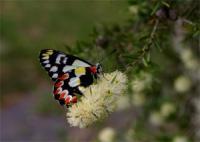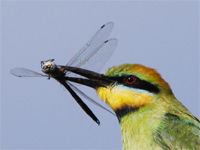Two locally occurring species, one a resident, the other a summer vagrant, can pose some identification challenges.
The Fuscous Honeyeater Ptilotula fusca is possibly the most abundant local honeyeater and can be found throughout the district, although it tends to be more common in larger, intact areas of forest and woodland.
The Yellow-plumed Honeyeater Ptilotula ornata is mainly a mallee species, found commonly to our north but a post-breeding wanderer to our area.
Yesterday at the Rise and Shine I observed a single P. ornata amongst possibly fifty Fuscous Honeyeaters that arrived to drink and bathe in a bush pool.
A careful look at the images below show the distinctive features of each species. Yellow-plumed Honeyeaters have a prominent yellow cheek plume and a heavily streaked breast. Fuscous Honeyeaters also have a yellow cheek plume but it is much less pronounced – some individuals also have faint streaking on the breast. In both the bill colour varies from entirely black while breeding, to black-tipped with a yellow base outside the breeding season. Juveniles of both species are duller, browner versions of the adults without the distinct markings.

Fuscous Honeyeater (non-breeding adult), Rise and Shine Bushland Reserve, 20th January 2024

Yellow-plumed Honeyeater (non-breeding adult)

II

III

IV

Fuscous Honeyeater
Also noted: Diamond Firetail, Striated Pardalote, Spotted Pardalote, Peaceful Dove, Dusky Woodswallow, Yellow-tufted Honeyeater, Brown-headed Honeyeater, White-plumed Honeyeater, Black-chinned Honeyeater, White-naped Honeyeater, Brown Treecreeper, Red Wattlebird, Olive-backed Oriole.




































































